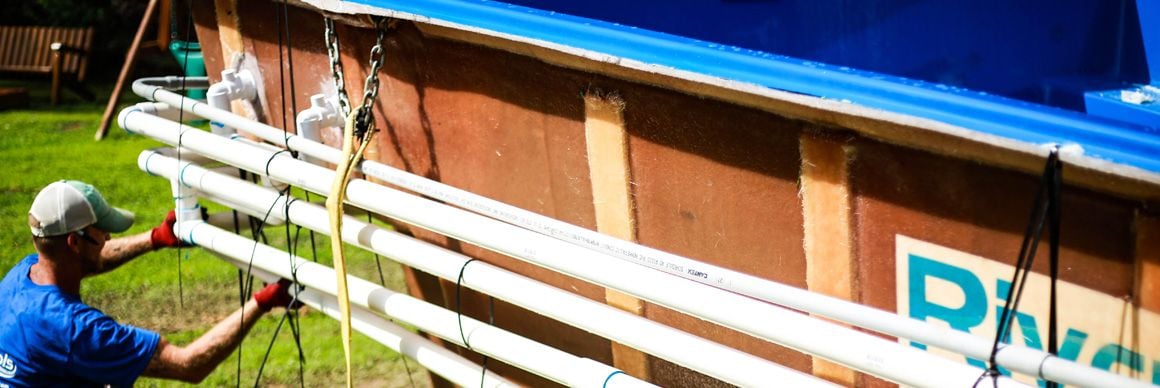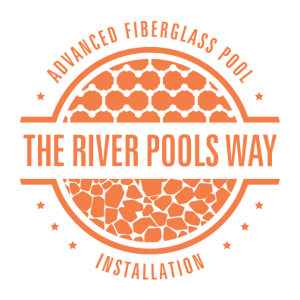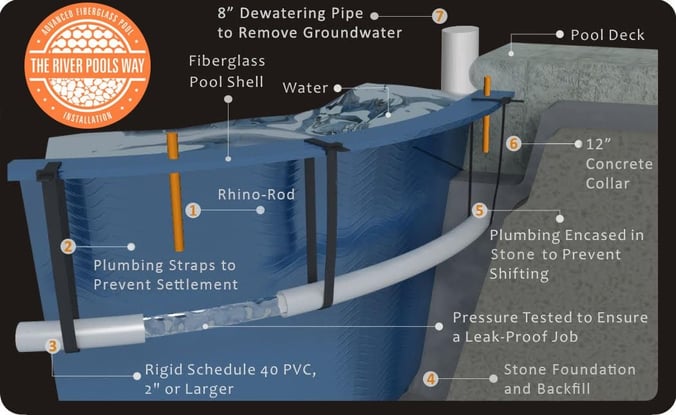
The River Pools Way: Fiberglass Pool Installation Problems Solved
 I'll be completely honest...At River Pools, we have made just about every fiberglass pool installation mistake possible.
I'll be completely honest...At River Pools, we have made just about every fiberglass pool installation mistake possible.
Our major learning curve occurred in our first years in business beginning in 2001. We fixed every problem and ensured our customers were happy, and the evidence is our reference list, which is over 1,000 names long. But we also asked a powerful question:
What are the underlying causes of these problems?
In the early days, we experienced these problems with fiberglass pools installations:
- leaks in pool fittings and plumbing lines
- bulges in the side walls of the fiberglass pool
- moving, shifting, and settling of the pool shell after installation
- separation between the pool shell and the patio
Our objective has always been to reduce the risk of fiberglass pool installation related failures as much as possible.
Consequently, the advanced installation methodology within The River Pools Way is a series of best practices, that together, have virtually eliminated the chance of these problems occurring in your backyard.

1. Our “River Rod” That Fuses the Pool Shell and Patio Together
One area of concern is where the pool shell and patio join.
We developed our River Rod to serve as a means to fuse the pool shell and patio together to prevent shifting, settlement, or movement of any kind that could result in structural failure.
The River Rod is a 12-inch long composite rod that we install into the top of the pool shell. It becomes encased in the concrete bond beam that is poured around the perimeter of the pool.
2. Plumbing Straps That Secure the Plumbing to the Pool Shell
One of the major causes of pool plumbing leaks is movement.
When pipes shift, this sets in motion a chain reaction that puts undue stress on the pipe, plumbing connections, and the components of the pool the plumbing is attached to such as return jets, skimmers, drains, etc.
In The River Pools Way, we secure the plumbing by fastening the pipes to the pool shell using a strap system that insures there is no stress placed on any component of the plumbing system.
3. All Schedule 40 PVC Hard Pipe
When installing a pool, there are basically two types of plumbing pipe to choose from: hard pipe or flexible pipe. In The River Pools Way, we use only hard pipe.
Because it does not flex and bend with the contours of the pool, it does require more effort to install, but because flexible pipe is actually not rated for underground use, we don’t feel it’s worth the risk.
4. Clean, Crushed Stone as Backfill Material
What is backfill material?
It is simply the material that we place under the pool and around the outside of the pool shell after it is set in the excavated hole. The use of clean, crushed stone backfill is imperative to the long term success of a fiberglass pool installation.
Sand, which is the traditional material used in the industry works well in areas with pure sandy soils, but it doesn’t take a soil specialist to understand what happens to sand when it becomes saturated with water: it liquifies.
Consequently, our experience has been that there is a much higher percentage of fiberglass pool installation issues when using sand as a backfill material such as:
- Settlement of the Pool Shell after installation
- Leaks developing from pressure on plumbing as a result of sand settlement
- Bulges in the side walls of the pool shell
These are challenges we faced and fixed early on, but they virtually went away overnight the moment we stopped using sand and began using clean, crushed stone as our backfill material.
It drains better, it doesn’t move, and doesn’t change it’s properties when wet.
5. Plumbing Encased in Stone to Prevent Plumbing Settlement
Unlike sand, the right stone backfill will not move or settle.
This creates a condition for long term plumbing success.
6. 12” Thick Concrete Bond Beam around Perimeter of Pool
All inground fiberglass pools require some concrete to be poured around their perimeter to stabilize the pool shell.
With The River Pools Way, this concrete bond beam is poured extra thick and flows under the lip of the fiberglass pool shell and encases the River Rod.
As this concrete “bites” around the River Rod and the lip of the pool, it “locks” everything into place, ensuring the pool and patio will be structurally secure for many, many years.
7. Sump Pipe for Monitoring/Removing Ground Water
Eventually, all fiberglass pools will need to be drained. There needs to be a means to inspect and remove any groundwater that is present around the outside of the pool shell to prevent damage from occurring. Because we think long term, our advanced installation methodology includes a “sump pipe” that allows you to do just that.
If you appreciate the concept of The River Pools Way, there is a way to ensure that your installer holds to the same rigid standards of excellence. It's called our River Certified Dealer Program.
You can learn more about our advanced installation as part of The River Pools Way.
And by the way, we manufacture a full line of fiberglass pool shells that we distribute throughout the U.S. through our authorized dealers. You can see our pool designs here and request a custom quote to see how much your pool project will cost.
Want a faster estimate? Try out our fiberglass pool pricing calculator tool below.

Want to see about how much that cost will be with all your favorite pool accessories?
Use our Design and Price Tool to walk through your options and approximate price!
As always, please leave any questions or comments you have below.
Up Next:
The Basics of Manufacturing and Installing a Fiberglass Pool
Is Sand or Stone Better Backfill for an Inground Fiberglass Pool?
Editor's note: This blog article was updated on January 2, 2019.
Editor's Note: This article was originally written by Jason Hughes on March 22, 2016. Any opinions expressed are those of the author. Any prices referenced were based on information that was readily available at the time.
River Pools is a brand of inground fiberglass pools produced in a manufacturing facility in Fortville, IN. While our expertise is in manufacturing fiberglass pools, we have access to a network of installers with expertise relating to project design, installation, and pool service. We often tap into this knowledge base and share information freely with homeowners, just like you, considering installing a swimming pool in your backyard.




